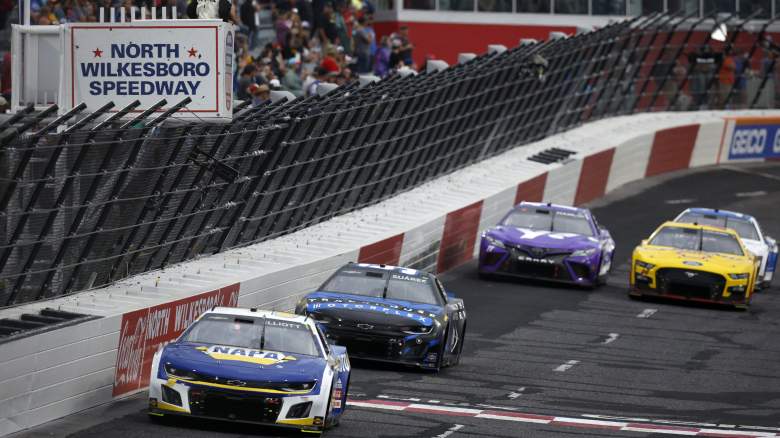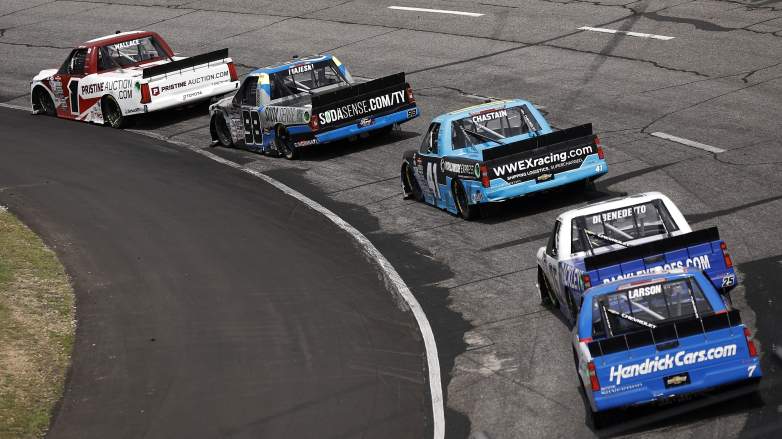
Getty Cup Series drivers race at North Wilkesboro Speedway.
The NASCAR Cup Series made history during the heat races at North Wilkesboro Speedway. The drivers competed on an oval for the first time while using the wet weather tires.
Rainfall at the North Carolina short track set up the historic moment. Track crews dried pit road, but the racing surface itself remained wet. Instead of delaying the race, the officials had the teams in the first heat put on the wet weather tires. Once they took the green flag, they marked a new moment in the sport’s history.
The drivers in the first heat completed 32 laps with the wet weather tires while talking about issues on the right front side. NASCAR ultimately threw the caution flag after determining that the track was dry enough to put on slicks.
However, the situation changed as the first group of cars headed down pit road. NASCAR decided that it would be best to have the teams stick with the wet weather tires for the rest of the first heat.
“It was fun to go through those transitions from a wet track and then kind of halfway dry,” said pole-winner Daniel Suarez. “It wasn’t 100 percent dry, but it was halfway there. We didn’t really know what to expect.
“The No. 9 did a better job than myself. I don’t know if he was either more aggressive or his car happened to work out better in the wet conditions. The first 10 laps, I just didn’t have anything for him. I was trying to break even and around lap 15 is when I said, ‘OK, he’s coming,’ and on Lap 20, I knew that I was better.
“It was fun to go through those transitions — learn a little bit about the tire and learn about the track. Unfortunately, tomorrow is going to be nice and sunny, so everything that we learned today — maybe it’s going to work for the future, but not for tomorrow.”
Heat 2 Had a Different Sequence of Events

GettyRyan Blaney dries his shoes before his heat race.
While the first heat ran the wet weather tires for all 60 laps, the second heat played out differently. NASCAR dried the track after Suarez won the pole and then the teams headed out for their pace laps with racing slicks on their stock cars.
The remaining 10 drivers were able to complete 24 laps around the short track while gaining some knowledge about tire falloff and lap times. Though they also had to switch to wet weather tires as rain began to fall once again.
At this point, NASCAR made history once again by racing on an oval for the first time with wet weather tires while the rain was actually falling.
“I had a lot of fun out there tonight,” Austin Dillon said after the second heat race. “It was weird because the rain tires were so much better than the regular slicks that I didn’t know how hard I could go. I was kind of saving there for a minute and I saw the No. 24 starting to struggle, so I thought we could run down the No. 17.
“When I got up there, the No. 24 started coming; he changed his line a little bit and picked up some speed. Have to go back and look at what he was doing. He seemed like he had a little wider arc than us. I was kind of running the low lane off of [Turn] 4. It’s cool when you can move around on the track and find subtle things and save tires. But the rain tires were very surprising. It was cool.”
“The tire was really nice,” Chase Elliott said. “The track is pretty much dry other than just some areas where I think it’s got some weepers. But I don’t know that this wouldn’t be a better race with those tires than it would our slicks. If the race isn’t good the first-half tomorrow, maybe we should all come in and put on these things and finish it out this way (laughs).”
Another Series Competed on an Oval With Wet Weather Tires

GettyCraftsman Truck Series drivers race at North Wilkesboro Speedway.
The two heat races marked the first time in Cup Series history that the drivers competed on an oval track with wet weather tires. However, it was not the first time for a national NASCAR series.
Back on April 14, the Craftsman Truck Series also made history. Heavy rainfall at Martinsville Speedway led to a wet track, but NASCAR was able to get the race started after some initial drying. The teams put on wet weather tires and completed the first 27 laps without issue.
The competition caution flew on Lap 27 as NASCAR officials had the teams switch back to the racing slicks. The drivers then completed 97 laps on the slicks before the rain began to fall once more. NASCAR ultimately called the race at that point and declared Corey Heim the winner.
“I thought it was great,” Ross Chastain told NASCAR Media. “I thought they did a good job to get the track dry of like standing water and then let us go. [The] tire had plenty of grip. This generation of rain tire, really everything I’ve seen out of it, is OK and right for the situation.”
Comments
NASCAR Makes Cup Series History at North Wilkesboro